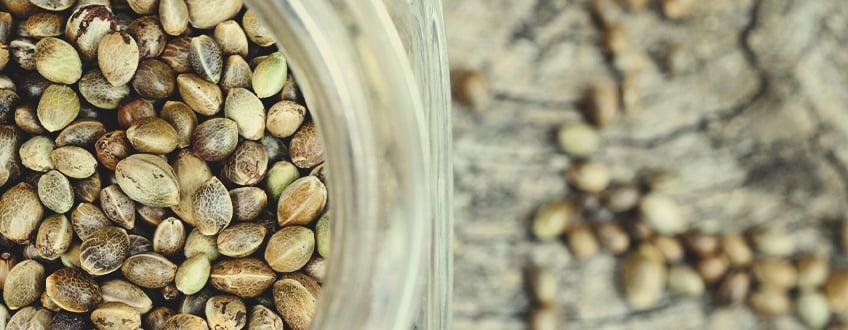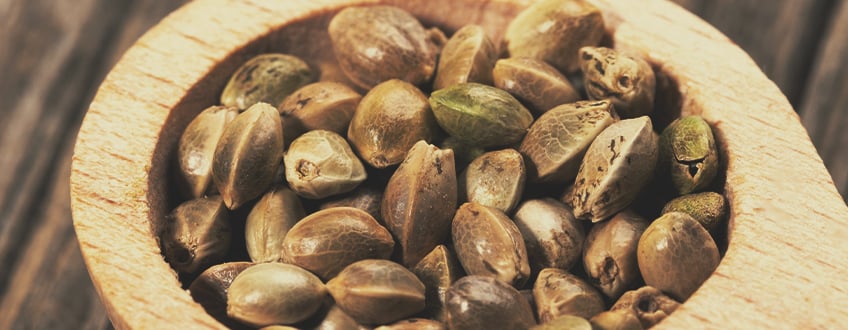Proper Techniques for Preserving Cannabis Seeds

Cannabis seeds possess a resilient exterior, giving them an appearance of durability. However, despite nature’s intention to equip them for various environments, cannabis seeds are not impervious. Swift fluctuations in temperature and excessive humidity, among other factors, can swiftly deteriorate a batch of seeds. Fortunately, taking care of your seeds is a straightforward process. Continue reading to discover the methods involved.
Alive and Thriving: The Vitality of Your Seeds
It is often overlooked, but it remains a fact: your cannabis seeds are living entities. Prior to germination, they enter a dormant phase similar to the hibernation of certain animals. Just like any other living organism, seeds have the potential to perish. Therefore, when storing your seeds, it is crucial to provide them with the ideal conditions to ensure their viability until the moment you decide to germinate and cultivate them.
Creating Optimal Environments for Cannabis Seeds
There are four primary adversaries that pose a threat to cannabis seeds:
1. Humidity
2. Temperature
3. Light
4. Oxygen
For optimal storage, it is advisable to keep your seeds in a cool, dark, and dry location. Whenever feasible, retain them in their original packaging. At Royal Queen Seeds, our packaging is meticulously designed to safeguard the seeds until you are prepared to sow them.
Exposure to light or sudden temperature fluctuations can prompt the seeds to deplete their nutrient reserves even before they are planted, resulting in insufficient nourishment for successful germination. Conversely, excessive humidity can foster the growth of fungi on your seeds.
The Impact of Humidity on Cannabis Seeds
Humidity poses a significant risk to your seeds, making it one of the foremost concerns. Let’s explore how varying levels of humidity (% relative humidity) impact cannabis seeds:
| LEVELS OF RELATIVE HUMIDITY |
EFFECTS OF HUMIDITY ON CANNABIS SEEDS |
| 80 – 100 % | Seeds germinate. |
| 40 – 60 % | Seeds increase respiration and seed storage fungi become a significant problem. |
| 20 – 30 % | Short-term storage. |
| 18 – 20 % | Medium-term storage. |
| 12 – 14 % | Long-term storage. |
| 8 – 9% | Shorter longevity than seeds stored at a slightly higher humidity. |
Proper Storage Guidelines: Where and How to Preserve Your Cannabis Seeds
When it comes to short-term storage, a dark cupboard or drawer with consistent temperatures is generally suitable. It is advisable to avoid storing your seeds in areas of your home that are prone to the natural temperature fluctuations of your local environment.
For instance, if you reside in a region characterized by warm daytime temperatures and cool nights, it is recommended to shield your seeds from these fluctuations and refrain from storing them outside in a shed or garage.
For extended periods of storage, the recommended approach is to place your seeds alongside a desiccant, such as silica gel, inside a sealed container within the refrigerator. However, it is crucial to note that opening the fridge door can lead to significant temperature fluctuations. If you happen to possess a secondary refrigerator that is utilized less frequently than the one in your kitchen, it is advisable to utilize that refrigerator for seed storage.
Furthermore, it is recommended to retain your seeds in their original packaging whenever feasible. In the event that you open a seed packet and have remaining seeds, promptly transfer the extra seeds into a sealed, airtight container.
Ziplock bags offer an excellent solution as they allow for the removal of air, creating a nearly vacuum-sealed container for your seeds. Once vacuum-sealed, place the bag inside a dark plastic bag or a light-shielding container to shield the seeds from fridge light.
When it comes to seed storage, dry fridges are preferable. The presence of humidity in the fridge poses a significant challenge, as humidity is more detrimental to seeds than temperature, light, or oxygen. Therefore, it is advisable to store seeds in No Frost fridges to mitigate the risk of humidity.
Feasibility of Freezer Storage for Seeds
Indeed, it is possible to store cannabis seeds in the freezer. Lower temperatures can decelerate their deterioration process. However, freezing seeds is typically unnecessary. By adhering to the conditions we previously described, you can effectively preserve your seeds for up to five years and achieve a high germination rate.
Deciding Between Planting and Storing: Choosing the Right Seeds
Before commencing the germination process, it is advisable to carefully examine your seeds and prioritize germinating those with intact outer shells. The outer shell serves as a protective barrier for the delicate genetic material contained within. Seeds exhibiting cracks or damage to the outer shell are considerably more susceptible and should not be stored.
At Royal Queen Seeds, we are dedicated to providing growers with superior genetics for their gardens. As part of our commitment, we meticulously inspect all of our seeds prior to packaging. If you happen to observe any damage to your RQS seeds, please promptly reach out to our customer service team for assistance.

Effective Techniques for Germinating Aging Cannabis Seeds
Sometimes, we stumble upon a peculiar seed hidden away in the depths of a forgotten drawer or cupboard. If you happen to come across such old cannabis seeds, consider these valuable insights for successfully germinating them:
- Pre-soaking with enriched carbonated water
To enhance the germination process of your aged seeds, it is advisable to immerse them in carbonated water infused with fulvic acid, germination booster, hydrogen peroxide, or gibberellic acid. For optimal outcomes, utilize water at room temperature and allow the seeds to soak in a dark location for a duration of 12 hours.
- Scar your seeds
Aged seeds frequently possess a resilient outer shell that can impede the absorption of moisture and warmth during germination. To facilitate this process, delicately scratch the surface of your old cannabis seeds using sandpaper. This gentle scarification, performed just before soaking, can greatly assist in promoting successful sprouting.
- Remove a seed’s ridge
Within the seed’s shell, there exists a slightly raised side known as the ridge. Similar to other sections of the shell, this ridge can develop increased toughness as time passes. Carefully eliminating it using a sharp Stanley blade can facilitate the sprouting process of your seed.
- Slice open your seed
As a final resort to initiate germination, making a small incision in the shell of your seeds can be beneficial. Nonetheless, it is crucial to exercise caution and avoid harming the internal embryo. Damaging the embryo will prevent the seed from germinating altogether.
Keep in mind that despite your efforts, certain aged seeds may simply refuse to germinate. Whenever feasible, it is advisable to refrain from purchasing more seeds than you intend to plant, thereby minimizing potential complications during germination.






